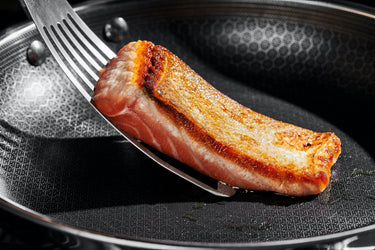Finally, Nail Cooking Fish At Home

In the realm of food worries, cooking fish is up there at the top. Perhaps this is because the stakes can feel high after spending money on a nice piece of fish. And there’s the finicky skin—won’t it just rip right off? These simple tips will ensure you cook every piece of fish to perfection, no matter the cooking method you choose.
First, decide how you’re going to cook your fish. Grilling is great in the summertime and for quick preparations. The oven is relatively foolproof and a fantastic way to throw together a dinner party-worthy fish dish, whether it’s a whole trout or a side of salmon. As for the stovetop? Well, that’s where things can get slightly tricky. But don’t worry, we’re here to walk you through the keys to finally nailing cooking fish at home.
No matter how you’re planning to cook your fish, it’s worth keeping a few tips in mind:
- Make sure it’s fresh: If it smells fishy—you know what we mean—don’t cook it. Fresh fish should smell like the sea. If you’re buying a whole fish, look at the eyes: they should be clear, not cloudy.
- If you’re using frozen fish, defrost completely: Cooking to the right temperature requires fully defrosted fish. If the center is still frozen, you risk overcooking the exterior.
- Dry the fish before cooking: Getting that perfectly golden sear or gorgeous char on your fish requires a dry piece of fish. Pat it dry with a clean dish towel (that you launder right after) or use paper towels.
- The fish spatula is your friend: A confident flip of the fish is much easier when you have a thin, metal spatula (also known as a fish spatula) that allows you to get underneath an entire fillet at once.
Cooking fish on the stovetop
A heavy-duty, nonstick pan is crucial when cooking fish on the stovetop, and we’re not just saying that because we’re biased. A heavy-duty material conducts heat more evenly for a restaurant-quality sear, while the nonstick ridges ensure the skin won’t stick to the pan.
Here’s how to do it: Start by seasoning the fish well with salt, pepper, and any desired seasonings. Then, add oil to your preferred pan (For single fillets, choose a small, 8-inch skillet; for 2 fillets, use a medium, 10-inch skillet; and for 4 fillets, go with a large, 12-inch skillet.) and heat until the oil shimmers. Now, add the fish skin-side down and cook until the skin is golden and crisp. (Resist the temptation to peek too often, which can affect the cooking.) Flip the fish and cook just a few minutes more, until the flesh side is golden and the interior of the fish is cooked to your liking.
- Want to practice? Try our recipe for Salmon Almondine, which walks you through getting a perfect sear, then making an almond-flecked lemon-caper sauce. Oh, and did we mention it has brown butter, too?

Grilling fish
Nailing fish grilling is easier than you think. The key is to get the grill hot enough that it chars the exterior. Hardy fish like tuna, swordfish, or salmon can stand up to the grill grates, but if you’re working with something more delicate (like sole, cod, or tilapia), you’ll want to use a cedar plank or the HexClad Grill Pan, grilling fish is easier than ever. The holes in the grates allow the flavorful smoke to permeate the fish while avoiding the dreaded collapse through the grill grates.
Here’s how to do it: Before cooking, coat the fish with a little oil and season with salt, pepper, and any desired seasonings. Heat the grill to medium-high heat, and place a grill basket on, if using. Add the fish, skin-side down, and cook without disturbing, until the interior of the fish is cooked to your liking.
- Pro tip: throw a halved lemon or lime on the grill. The char brings out extra depth of flavor, while the heat means the citrus will release more juice.
Cooking fish in the oven
The oven can do wonders with fish. Whether you want to cook a few filets quickly or slow-roast a large side of fish, this hands-off method is ideal for when you’re making side dishes or simply want something easy.
- Broiler: The broiler is the lazy fish cook’s back pocket secret. Simply preheat the broiler to high. Season the fish and place it on a baking tray, skin-side up (do not line with parchment, which could catch fire). Broil for 2 to 3 minutes, or until cooked to your liking. Do not walk away! Broilers work quickly.
- Slow-roast: A large side of fish is ideal for slow-roasting since it will vary in texture. This way, part of the fish won’t get overcooked while the rest catches up. Season the piece of fish and place in a parchment-lined baking pan. Add ¼ cup water to the pan and cover tightly with foil. Bake at 300ºF until the fish is fork-tender and cooked to your liking.
- Roast: The broiler can be high stress and temperamental. Roasting fish at 400ºF, on the other hand, is pretty fool proof and great for fillets. Season the fish and place on a parchment-lined baking sheet. Roast until the fish is fork-tender and cooked to your liking.





